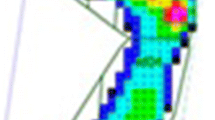Summary
A long-term follow-up (3.5 years mean) of 106 operated ankle features out of 167 patients revealed 73.7% excellent and good, 16% acceptable and 10.3% poor results. Anatomically exact reduction was shown to be a prerequisite for good results and was seen in 77.2% of all cases. By neglecting biomechanical principles an insufficient reconstruction led to a poor final outcome. But even in 11% of the excellent operatively treated fractures late arthrosis developed. Statistical analysis showed that the onset of posttraumatic arthrosis was correlated with and predicted best by the number of single lesions. Dorsiflexion testing was the clinical parameter correlating best with the extent of the injury, the degree of arthrosis and the subjective complaints. This underlines the importance of assessment of dorsiflexion as a clinical screening test for remaining sequelae after ankle fractures.
Zusammenfassung
Anhand der Daten einer retrospektiven Studie über 167 operativ versorgte Sprunggelenksfrakturen wird das Krankengut und die Ergebnisse einer Nachuntersuchung von 106 Patienten dargestellt. Nach durchscnittlich 31/2 Jahren wurden 73,7% sehr gute und gute, 16% ausreichende und 10,3% schlechte Spätergebnisse verzeichnet. Durch statistiche Analyse wurden als prognostiche Kriterien hinsichtlich der Arthroserate der Einfluß des Operationsergebnisses sowie des Verletzungsausmaßes und des Frakturtyps untersucht. Die anatmisch exakte Reposition und Osteosynthese, die wir bei 77,2% feststelltem, muß als Voraussetzung für ein gutes Ergebnis angesehen werden. Bei Vernachlässigung biomechanischer Prinzipien führte ein insuffizientes postoperatives Resultat zu einem schlecten Nachuntersuchungsergebnis. Trotz optmaler operativer Versorgung mußte eine Arthroserate von 11% hingenommen werden. Die Prognose nach Sprunggelenksfrakturen zeigte sich maßgeblich durch den Schweregrand der Verletzung, der durch die Zahl der Einzelverletzungen charakterisiert war, gekennzeichnet. Entsprechend bot die genetische Klassifikation nach Lauge-Hansen eine größere prognotische Ausagekraft als die Webersche Einteilung.
Als klinisch leicht faßbar und mit dem Verletzungs-ausmaß wie auch der Arthroserate sowie den subjektiven Beschwerden am besten korrelierender Parameter erwies sich die Funktionsprüfung der Dorsal-extension.
Similar content being viewed by others
References
Barnett CH, Napier JR (1952) The axis of rotation at the ankle joint in man. Its influence upon the form of the talus and the mobility of the fibula. J Anat 86:1
Beck E, Brade A, Schneider-Sickert F, Ziernhöld G (1978) Ergebnisse nach operativ behandelten Knöchelbrüchen. Unfallheilk 81:309
Hugheg JL, Weber H, Willenegger H, Kuner EH (1979) Evaluation of ankle fractures: nonoperative and operative treatment. Clin Orthop Relat Res 138:111
Kuner EH, Weyand F, Härtwig J, Springorum HW, Haag U, Glaser H (1975) Ergebnisse konservativ und operativ behandelter Knöchelbrüche. Unfallchir 1:39
Lauge-Hansen N (1952) Fractures of the ankle. IV. Clinical use of genetic roentgen diagnosis and genetic reduction. Arch Surg 64:488
Martinek H, Egkher E (1978) Untersuchungen zur Biomechanik des oberen Sprunggelenkes bei Verkürzung des Außenknöchels. Arch Orthop Trauma Surg 91:39
Niethard FU, Plaue R (1977) Das hintere Tibiakantenfragment als prognostisches Kriterium. Arch Orthop UnfallChir 87:213
Pankarter F (1977) Ergebnisse nach operativer Versorgung von Verletzungen (Frakturen) des oberen Sprunggelenkes. Unfallheilkunde 80:243
Ramsey PL, Hamilton W (1976) Changes in tibiotalar area of contact caused by lateral talar shift. J Bone Jt Surg 58-A:356
Riede UN, Hehne HJ (1978) Inkongruenzarthrose. Hefte Unfallheilk 133:12
Schenk R (1978) Anatomie des oberen Sprunggelenkes. Hefte Unfallheilk 131:1
Stadler J, Gauer E, Rüedi Th (1975) Operativ versorgte Malleolarfrakturen. Ergebnisse nach 3–4 Jahren mit besonderer Berücksichtigung des Talusprofils. Arch Orthop Unfall-Chir 82:311
Weber BG (1966/72) Aktuelle Probleme in der Chirurgie. Band 3: Die Verletzungen des oberen Sprunggelenkes. H. Huber, Bern Stuttgart Wien
Yablon J, Heller FG, Shouse L (1977) The key role of the lateral malleolus in displaced fractures of the ankle. J Bone Jt Surg 59-A:169
Author information
Authors and Affiliations
Rights and permissions
About this article
Cite this article
Zenker, H., Nerlich, M. Prognostic aspects in operated ankle fractures. Arch. Orth. Traum. Surg. 100, 237–241 (1982). https://doi.org/10.1007/BF00381663
Received:
Accepted:
Issue Date:
DOI: https://doi.org/10.1007/BF00381663




